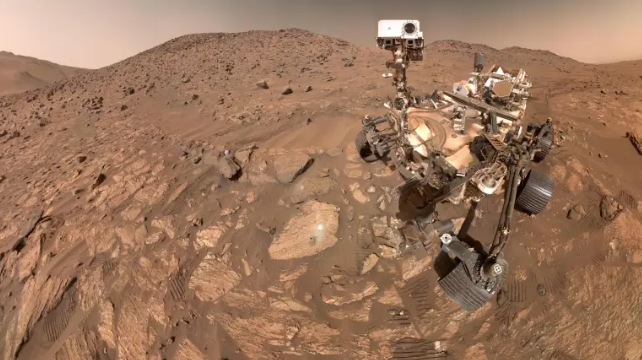Where is life? Is it aliens in the stars, millions of light-years away, or AI roaming the cosmos? While humanity tends to focus on the endlessness of space, NASA claims there may have been life on our very own Red Planet. On February 18, 2021, Perseverance landed on Mars’ soil to research the planet. One of these discoveries was “Cheyava Falls,” a seemingly random rock. However, under keen observation, it has been discovered as a potential biosignature that could signify previous life on the barren planet. How has NASA obtained this biosignature?
One of Perseverance’s goals was to find life or remnants of it. Perseverance was positioned to land in the Jezero Crater, an area hypothesized to be a lake. Perseverance has the unique ability to collect specific rock samples to analyze the previous climate of Jezero Crater. NASA’s prior planning and hypothesizing have culminated in collecting Cheyava Falls in the exact spot needed. So why is Cheyava Falls so significant?
After further research, Cheyava Falls was discovered to have leopard spots as NASA coined in the rock. As seen in the image NASA has provided, these leopard spots could represent microbial life feeding on the rock. To understand this significance, the signs of life must be understood. Life needs water and organic compounds to survive. As stated, the Jerero Crater is thought to have previously contained water, and Cheyava Falls was found to be rich in organic compounds, allowing life to propagate. However, for something to be a biosignature, it must be a substance or object that can only be created by living things, which is why these leopard spots are essential. When microbial life consumes organic compounds, it releases waste products, which could explain the spots. This is the only hypothesis that NASA has presented to explain these spots, meaning this could be a biosignature. However, NASA states that more research is needed to make this potential biosignature certain.
NASA follows COSPAR’s planetary policy. The problem is that to continue research on Cheyava Falls, NASA must use its labs on Earth; however, COSPAR has strict restrictions on back contamination from Mars. To prevent an alien organism or disease from Mars, NASA must follow strict limits, like bringing the rock in a sterile container and storing it in a containment facility. This slows the research process as engineers must design robust systems per COSPAR’s policy. However, critics like Chad Pozaryic, a former NASA researcher, stated that this policy only slows research. Pozary calls out that Mars is a barren planet that is being blasted with radiation. It is doubtful that any organism lives on Mars, and if so, even more improbable is that this organism is a threat to us. Pozary claims this is only a politically induced fear with no scientific background. Nevertheless, NASA has not announced its withdrawal from COSPAR’s policy, so research on Cheyava Falls is expected to be slow.
Cheyava Falls could mark the inflection point of humanity, the realization that humanity is not alone. If these leopard spots are remnants of previous life, this could be the most significant discovery in human history. While research may be prolonged, scientists can’t stop themselves from being excited by this biosignature. Cheyava Falls could be the rock to end the search for life and usher in a new revelation of our universe.






